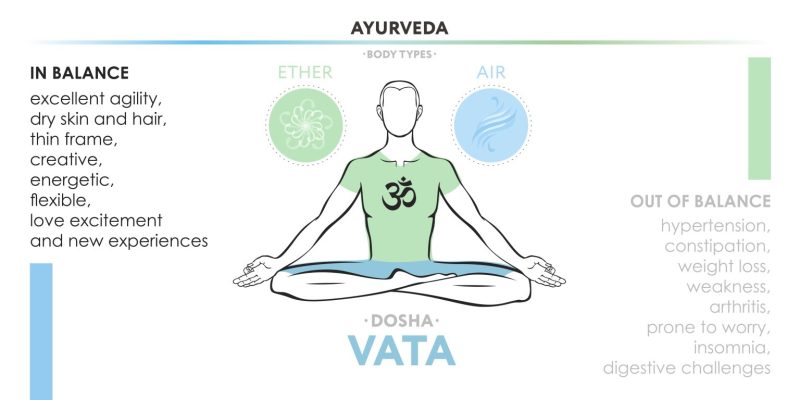Blogs
Unlocking the Secrets of Vata Dosha: A Comprehensive Guide
Introduction to Vata dosha
Vata is one of the three basic doshas identified in Ayurveda. The vata dosha is composed of air and ether. Vata is characterised by natural components, particularly air, and is light, chilly, airy, and dry in essence. The vata regulates all of the body’s motions, including blood circulation, breath flow, cardiac rhythm, pulse movement, and neural transmission. The Vata dosha is also associated with traits like as inventiveness, excitement, quick thinking, passion, and so on.
Because Vata (the air element) affects so many vital elements of our bodies, an imbalance or aggravation of the Vata dosha can result in a variety of mental and physical ailments.

Characteristics of VATA People
Certain features might assist an Ayurvedic practitioner assess whether or not your body’s constitution is Vata-dominant. The following are some of the most prevalent traits of persons who are Vata dominant.
- Vata folks have a thin and fragile physical frame.
- They often have dry, dull, and flaky skin.
- Vata persons may have thin, dry, or brittle hair.
- Vata persons may experience irregular digestion.
- They often become bored with monotonous work and want variation in their life.
- People with a dominating vata may be temperamental and unpredictable.
- They prefer to speak and move quickly. This trait also makes them flexible.
- Vata individuals may detest cooler temperatures since they are particularly sensitive to them.
- They might quickly become overwhelmed in high-pressure circumstances.
- People with vata dosha tend to be abstract thinkers who excel as authors, painters, and artists.
How To Balance Vata Dosha
The Vata dosha is fast-paced, breezy, light, and cool. People with prominent vata dosha have similar physical and mental features. As a result, individuals must adopt a lifestyle that calms vata and maintains equilibrium. They must include foods and practices that are diametrically opposed to Vata, namely chilly, dry, and airy. Vata’s dryness, for example, may be readily alleviated by including ghee or sesame oil into their diet. Furthermore, warm food that has been carefully seasoned with spices such as turmeric, pepper, or cinnamon might help to counteract Vata’s chill. A routine Abhyanga (Ayurvedic massage) may help Vata persons with their physical dryness.
VATA BODY TYPE IN DETAIL
Physical features of vata individuals:
People with a vata dosha or a vata constitution typically have a slender and feeble bodily frame. Their joints and bones are prominent, and they have lengthy toes and fingers. They might be tall, with prominent cheekbones. A vata person’s skin is often dry, flaky, chilly, and dull, with visible veins. Because of the presence of the air element, their skin may be unevenly toned, and they are more susceptible to develop dark circles. The overall structure is often bony. A Vata person’s eyes may be tiny, and their teeth are often misaligned.
A Vata person’s hair may seem lifeless and feel thin, brittle, and dry. They are also prone to having dry and flaky scalps.
People dominated by the Vata dosha may walk and speak rapidly, just as air flows quickly. Their appetite is generally erratic, and even when they eat substantial meals, they may struggle to gain weight. They usually lose weight after undertaking modest activity. They usually have abstract ways of thinking.
Vata individuals have the following mental and emotional characteristics:
They are regulated by the Vata elements and have passionate, creative, and exuberant dispositions. However, they may also be extremely sensitive. Their bodies contain air, which might cause them to be extremely unpredictable. When confronted with people, places, or events that overwhelm them, Vata people may get worried and apprehensive. However, because of their adaptability, they may transition from emotional and chaotic to calm and rational. They also tend to lose interest or become bored easily, and they are continuously switching from one work to the next.
Aside from the aforementioned characteristics, Vata types may have a great ability to comprehend information but a forgetful memory. Vata types excel in professions that require imagination, creativity, and communication. As a result, careers in media, education, research and development, marketing, advertising, and writing may be a good fit.
Common diseases among Vata people
Vata dosha, which is ruled by the air and sky components, may have an effect on the body’s air element. As a result, persons with dominant vata frequently have air- or movement-related issues within their bodies, such as:
- Bloating and constipation
- Stiffness
- Skin cracks and dryness.
- Dehydration
- Poor blood circulation.
- Breathing issues
- Anxiety and Fear
- Muscle loss
- Digestion difficulties
- Numbness or tingling sensations
- Muscle and joint ache.
Diet and Lifestyle for Vata People
To avoid the ailments listed above and live a healthy life, persons with a vata constitution should eat a vata-pacifying diet and make lifestyle changes that balance the vata dosha in their bodies.
- Maintain a healthy bodyweight Because vata persons are typically slim, they should avoid strenuous activity or severe cardio, which might contribute to more weight loss. They should have a balanced and healthy meal according to the Ayurvedic clock, as well as prepared fruits and vegetables, and with adequate rest and modest exercise, they should be able to maintain their ideal weight.
- Eat light, modest meals. A person with an exacerbated vata may have difficulties digesting and feel bloated; in this instance, they should strive to consume well-cooked food in moderate quantities so that their digestive system is not burdened.
- Vata persons should undergo Ayurvedic detox, such as seasonal panchakarma and Ayurvedic enemas, to rid their bodies of toxins and improve blood and air circulation.
- Oil Massage: Vata’s dryness expresses both within and externally. To combat external dryness, oil massage and treatments such as Abhyanga or Shirohara are beneficial to the body. The mild stimulation of an Ayurvedic massage with herbs soaked with heated oil not only relieves skin dryness and flakiness, but also strengthens the muscles and bones. To combat internal dryness, include ghee or sesame oil in your diet.
TIPS FOR BALANCING VATA DOSHA
To balance your vata dosha, consider the following food, activity, and herbal recommendations.
To determine if your personal constitution is vata dominant or not, take our YATAN dosha quiz, complete a quick questionnaire, and receive the findings. It will give you a general notion of your dosha type. However, it is still suggested that you contact us at Kairali Ayurvedic Centre so that our Ayurvedic practitioner can identify your dominant dosha type. Depending on your dosha type, you may eat certain foods and make lifestyle modifications to improve your overall health.
Foods to Eat/Vata Diet
For a vata-dominant person, soaked nuts (walnuts, cashews, almonds, and pistachios), whole grains, milk or soy milk, ghee, oats, rice, quinoa, avocados, warm soups, herbal teas, and spices such as turmeric, fennel, garlic, ginger, cloves, cumin, coriander, and black pepper can be consumed. Eat homemade, seasonal, and fresh cuisine. Avoid cold and frozen meals, which might increase vata.
Activities/Exercise for Vata People
To further care for your body and maintain your Vata balance, you may add certain physical exercises into your daily routine, which will benefit both your physiological and mental health. You may try.
- Yoga poses include Tadasana (mountain posture), Vrksasana (tree stance), and Viparita Karani (legs-up-the-wall pose).
- Pranayama: Some of the greatest pranayama techniques for Vata balancing include Nadi Shodhana (alternate nostril breathing), Ujjayi (ocean breathing), and Brahamari.
- Swimming: A light swim workout will improve your blood circulation and vigour.
- Brisk Walking: A short, light, and easy walking exercise lasting 20-30 minutes may also be useful.
- Meditation: If your mind is agitated, overloaded, or nervous, merely focusing on your breathing will help you relax.
Please keep in mind that the activities listed above should only be performed by people in good health. If you have a chronic or underlying health issue, check your doctor before beginning any new exercise or fitness programme.
Herbs and supplements to consume
Ayurveda provides a few plants to help balance Vata. Herbs such as Brahmi, Triphala, Shatavari, and Ashwagandha may be useful. Please consult an Ayurvedic practitioner before using any Ayurvedic medicines or supplements.
Follow us on Instagram


